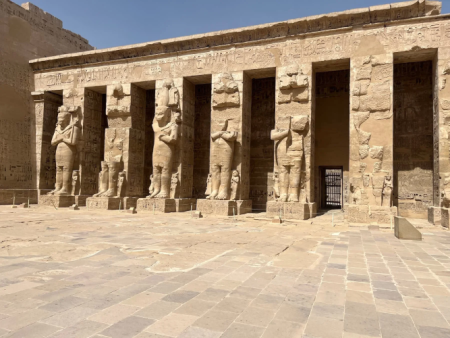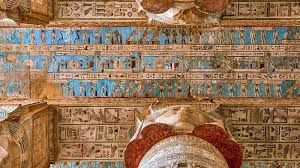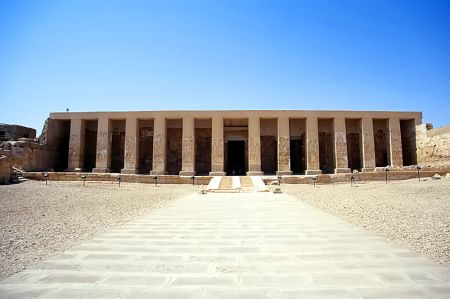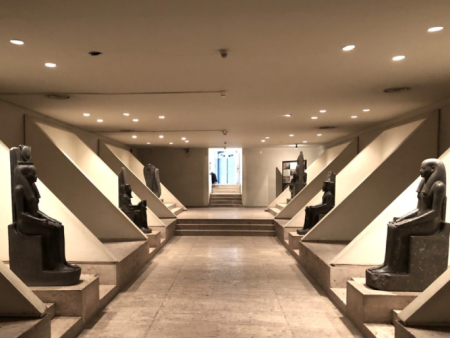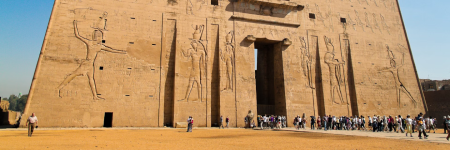The Avenue of Sphinxes

The Avenue of Sphinxes – The Majestic Processional Pathway of Ancient Luxor
The Avenue of Sphinxes, known in ancient Egypt as 'The Path of the Gods,' stretches majestically between the Karnak Temple and the Luxor Temple in the heart of Luxor City. This awe-inspiring avenue, lined with hundreds of imposing sphinx statues, evokes the grandeur of ancient Thebes, once the religious capital of Egypt. Walking along this historic path feels like stepping back through millennia, retracing the footsteps of pharaohs, priests, and pilgrims who once participated in divine processions during the Opet Festival—a celebration linking humans with the gods.
Recent restoration efforts have brought the Avenue of Sphinxes back to life, transforming it into one of the most iconic archaeological landmarks in Egypt. Stretching over 2.7 kilometers, this monumental pathway was originally lined with around 1,350 sphinx statues, each carved from sandstone and positioned with symbolic precision to honor the god Amun-Ra. The Avenue connected the spiritual realms of Karnak and Luxor Temples, serving not merely as a road, but as a sacred artery through which divine energy flowed. Today, it stands as a testament to the architectural mastery and religious devotion that defined ancient Egyptian civilization. For anyone embarking on Egypt Travel Packages, this site is a breathtaking highlight that encapsulates the timeless spirit of the Nile Valley.
Origins and Construction of the Avenue of Sphinxes
The origins of the Avenue of Sphinxes date back more than 3,000 years, with construction believed to have begun during the reign of Pharaoh Amenhotep III. However, its completion came centuries later under Nectanebo I of the 30th Dynasty. The pathway’s design symbolizes the divine connection between the gods of Karnak—Amun, Mut, and Khonsu—and their earthly representations in Luxor Temple. As pharaohs expanded and renovated the temples, the avenue evolved accordingly, reflecting the continuity of Egypt’s religious and political history.
Each sphinx along the route was carefully oriented to face inward, embodying protection and reverence. Some statues possess ram heads—representing Amun—while others feature human heads symbolizing the pharaohs. Archaeological evidence suggests the avenue once boasted chapels, kiosks, and ceremonial stations used during festivals. The precision of the sandstone alignment, paired with inscriptions along the course, illustrates the extraordinary craftsmanship and devotion of the ancient builders. Visitors exploring this monumental boulevard as part of Egypt Nile Cruises often marvel at the intricate details visible even after thousands of years.
The Opet Festival: A Divine Journey Along the Avenue
The Avenue of Sphinxes served as the ceremonial route for the Opet Festival—one of the most significant religious celebrations in ancient Egypt. During this grand event, the statues of Amun, Mut, and Khonsu were carried in sacred barques along the avenue from Karnak to Luxor Temple, symbolizing renewal and fertility. Crowds of devotees lined the path, offering prayers, incense, and songs to welcome the gods. The festival reinforced the pharaoh’s divine right to rule and the unity between heaven and earth.
Records from temple reliefs and papyrus texts describe the vibrant nature of these processions: music, color, and ritualized dance filled the air. The Avenue, illuminated by torches and decorated with garlands, became a living theater of faith. This spiritual tradition continued for centuries, embedding the avenue deep within Egypt’s cultural identity. Those fascinated by the spiritual essence of ancient Egypt often pair visits to this sacred path with tours of the Temple of Hatshepsut or the Valley of the Kings to trace the continuity of divine worship across millennia.
Rediscovery and Restoration of the Avenue of Sphinxes
For centuries, the Avenue lay buried beneath layers of sand and urban expansion. Its rediscovery began in the 1940s when Egyptian archaeologists first unearthed sphinx fragments while conducting excavations near Luxor Temple. Over the following decades, successive teams painstakingly uncovered more of the avenue, revealing its true scope and grandeur. However, it wasn’t until the 21st century that large-scale restoration efforts commenced, fueled by both national pride and global archaeological interest.
By 2021, the Avenue of Sphinxes had been almost completely cleared and revived, culminating in a spectacular reopening ceremony broadcast worldwide. The restoration involved relocating modern structures, reconstructing missing statues, and restoring ancient paving stones that once guided royal feet. The project not only preserved Egypt’s heritage but also reignited global fascination with Luxor as the world’s largest open-air museum. Many travelers now include the restored avenue in their Egypt Luxury Tours itineraries, seeking to witness the living legacy of pharaonic splendor.
The Artistic and Symbolic Significance of the Sphinx Statues
The sphinxes that line the avenue are far more than ornamental guardians; they embody deep layers of symbolism. The hybrid lion-human or ram-headed designs represent strength, wisdom, and divine authority—core attributes of Egyptian kingship. The avenue’s alignment along the east bank of the Nile further reinforces the connection between life, light, and resurrection. Each statue, though weathered by time, retains its aura of majesty, gazing eternally toward the temples as if standing guard over the city’s sacred heart.
Art historians note subtle variations in the sphinxes’ features, reflecting changes in stylistic preferences across dynasties. Some bear inscriptions linking them to specific rulers, while others remain anonymous sentinels. These details allow visitors to trace artistic evolution across centuries. When paired with visits to sites like the Great Pyramids of Giza or the colossal Sphinx Statue, the avenue offers an unparalleled glimpse into Egypt’s sculptural mastery.
Walking the Avenue Today: A Journey Through Time
Today, strolling along the Avenue of Sphinxes is an unforgettable experience that merges archaeology with spirituality. As you tread the ancient limestone, you can almost hear the echoes of priests chanting invocations to Amun-Ra and envision the golden barques gliding toward Luxor Temple. The setting sun casts a copper hue across the sphinxes, making the entire path glow with mystical allure. Guided tours illuminate the history behind each section, unveiling hidden details that casual eyes might miss.
Modern lighting installations now enhance night visits, creating an ethereal atmosphere that rivals any world monument. Walking tours and evening light shows showcase the restored grandeur of the site, making it a staple of Cairo Day Tours extensions and broader Egypt Vacations Packages. The Avenue of Sphinxes isn’t just an archaeological marvel—it’s a spiritual encounter, a living bridge connecting the ancient and modern worlds.
The Cultural and Historical Importance of the Avenue of Sphinxes
The Avenue of Sphinxes stands as a symbol of Egypt’s enduring devotion to the gods and its mastery of monumental architecture. Its rediscovery has deepened our understanding of how religion, politics, and art intertwined in pharaonic society. The avenue’s alignment with astronomical and spiritual principles underscores the Egyptians’ profound cosmic awareness. As part of Luxor’s ancient landscape, it complements other treasures such as the Colossi of Memnon and the Luxor Museum, forming an unmatched cultural ensemble.
Tourism along the Avenue of Sphinxes also fuels Egypt’s modern economy, providing sustainable opportunities for local communities and inspiring global appreciation for ancient heritage. The site’s global prominence helps position Luxor as a must-visit destination for history enthusiasts and cultural travelers alike. Through ongoing preservation, Egypt continues to assert its role as guardian of one of humanity’s greatest legacies.
Frequently Asked Questions About the Avenue of Sphinxes
1. How long is the Avenue of Sphinxes in Luxor?
The Avenue of Sphinxes spans approximately 2.7 kilometers (1.7 miles), connecting Karnak Temple to Luxor Temple. Archaeological surveys confirm that it once featured around 1,350 sphinx statues placed symmetrically along both sides, forming a grand processional route for religious ceremonies.
2. When was the Avenue of Sphinxes built?
Construction of the Avenue began during the reign of Pharaoh Amenhotep III around 1400 BCE and was later completed during the 30th Dynasty under Nectanebo I. Over several centuries, successive rulers extended and renovated the avenue to maintain its ceremonial importance.
3. What was the purpose of the Avenue of Sphinxes?
The Avenue of Sphinxes served as a sacred processional road used during the Opet Festival to transport the statues of deities from Karnak Temple to Luxor Temple. It symbolized the divine connection between the gods and the pharaoh, reaffirming the ruler’s legitimacy and the prosperity of Egypt.
4. Can visitors walk the entire Avenue of Sphinxes today?
Yes, visitors can now walk the full length of the restored Avenue of Sphinxes. The path has been reopened to the public, complete with guideposts and lighting for evening visits. This experience allows travelers to relive one of the most remarkable processional routes of the ancient world.
5. Why is the Avenue of Sphinxes important to Egyptian heritage?
The Avenue of Sphinxes is crucial to Egyptian heritage because it embodies the artistic, spiritual, and architectural genius of ancient civilization. Its rediscovery and restoration have reaffirmed Egypt’s commitment to preserving its unparalleled cultural identity and inviting the world to experience its timeless grandeur.






